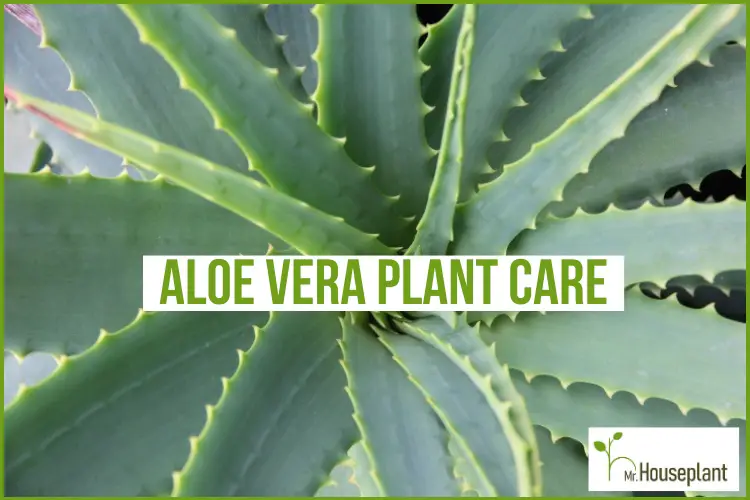
Aloe Vera plant care is fairly simple – it’s one of the low-maintenance plants. Read on to learn everything from the light requirements, watering, soil and repotting to pruning, common problems and how to fight pests and diseases when growing Aloe Vera plant.
| Botanical Name (Latin Name/Scientific Name): | Aloe Barbadensis |
| Common Name: | Aloe Vera |
| Light: | low light-tolerant |
| Watering: | when the soil dries out to the bottom of the pot |
| Soil: | succulent or cacti mix |
| Repotting: | Once a year |
| Temperature: | between 21 to 30 C° (70 to 85 F°). |
| Humidity: | 5% to 25%, but adapts well to high humidity |
| Toxicity for Pets: | Yes |
| Toxicity for Humans: | No |
| Propagation: | division |
| Pruning: | prune dead or diseased growth or when you want the plant to branch out |
Light Requirements
| Minimal amount of light: | 500 lux (50 FC) |
| Optimal amount of light: | 40,000 lux (4,000 FC) |
| Direct sun tolerance: | 8 hours |
| Category: | low light tolerant |
Aloe Vera plant grows and flowers best in full sun. However, it can get sunburned if exposed to direct sunshine straight away. Sounds complicated? Not really. Here’s how to provide sufficient light to your Aloe.
Find a spot with the indirect sun – this spot will be a temporary home for your plant. Your next step is to expose Aloe Vera to direct sunlight – only one hour a day. You’ll do this by moving the pot to an area with direct sun for one hour daily. Repeat this process every morning for one week. Once the plant is used to getting one hour of sunshine, go ahead and increase exposure to two hours a day. Each week, you’ll increase the length of exposure to direct sun by one hour. One hour a day of full sun in the first week, two hours a day of full sun in the second week, and so on. Continue increasing the amount of direct sunshine gradually until it’s time to find a new, permanent spot for your Aloe plant.
The idea is for the plant to receive direct sunlight all day long but you must make the transition from indirect light to full sunshine gradually. Otherwise, your Aloe Vera plant may experience stress and get sunburned.
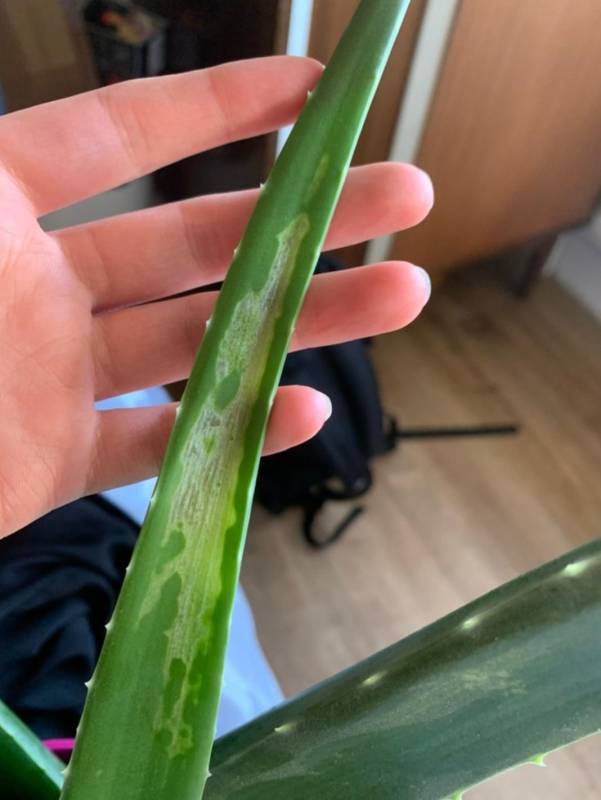
Sunburned aloe plant
Watering
How Often to Water Aloe Vera?
Great news for forgetful plant parents – Aloe doesn’t need to be watered often. The watering frequency will be different for each person depending on their environment. Allow the soil to dry out completely before you water it. Stick a chopstick to the bottom of the pot and once it comes out fully dry, without any soil stuck to it, it’s time to water. This can be anywhere from once a week or bi-weekly, to once every three weeks. During the winter, water even more sparingly than in summer.
Humidity and sunlight play an important role in how often your plant needs water. That’s why you must keep an eye on your plant and find a watering schedule that’s suitable for your specific Aloe.
If the humidity in your home is high (over 60-70%), aloe will lose less water through evaporation through the leaves. This means the roots will take up less water from the soil and as a result, the soil will stay wet longer. So in homes with high humidity, aloe will need to be watered less frequently than in homes with lower humidity.
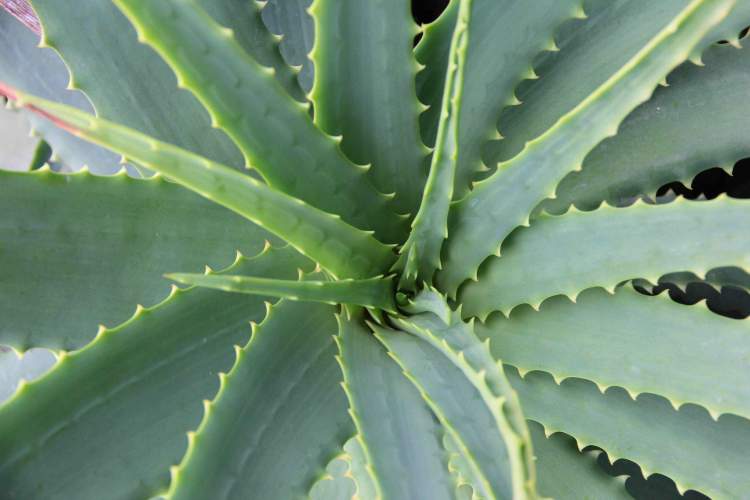
Aloe Barbadensis Miller known as Aloe Vera plant, Pixabay
The more light your aloe gets, the more it will photosynthesize and the more water the plant will use and uptake from the soil. So the more light, the faster will the soil dry out and you will need to water more frequently. In low light, the plant will photosynthesize less, will use less water from the soil and as a result the soil will stay wet longer and will need to be watered less frequently.
Check out my video to learn about four different methods to determine if it’s time to water your plants:
Do You Water Aloe Vera from Top or Bottom?
You can water Aloe Vera plant from the top or the bottom, it doesn’t make a difference. The main thing is to wait until the soil is fully dry, all the way to the bottom of the pot, before watering.
How Much Water Does an Aloe Plant Need?
The amount of water will be different for each plant, depending on a lot of factors – plant size, pot size, potting soil, pot type, amount of light, humidity…. In general, for aloe, less water is better than more. These succulents will handle drought much easier than being overwatered. To secure optimum Aloe Vera plant care, follow a thorough-and-infrequent watering method.
Water the soil thoroughly and wait for the water to start coming out of the bottom of the pot.
After watering, scratch the soil surface and make sure that the soil is wet an inch below the top. A lot of potting mixes are made of peat moss and as peat moss is hydrophobic (it repels water when dry), it’s possible that the water comes out the bottom of the pot right away, but the soil doesn’t absorb much of it and stays dry an inch below the top.
In that case, repeat watering until the soil is fully saturated. Also leave the water in the saucer for about 30 minutes so the soil has a chance to absorb it. After 30 minutes, spill the excess water from the saucer.
Make sure that the soil dries out in about 7-10 days maximum. If that is not the case, increase the amount of light, switch to a more porous potting mix (for succulents and cacti) or move the aloe to a terracotta pot.
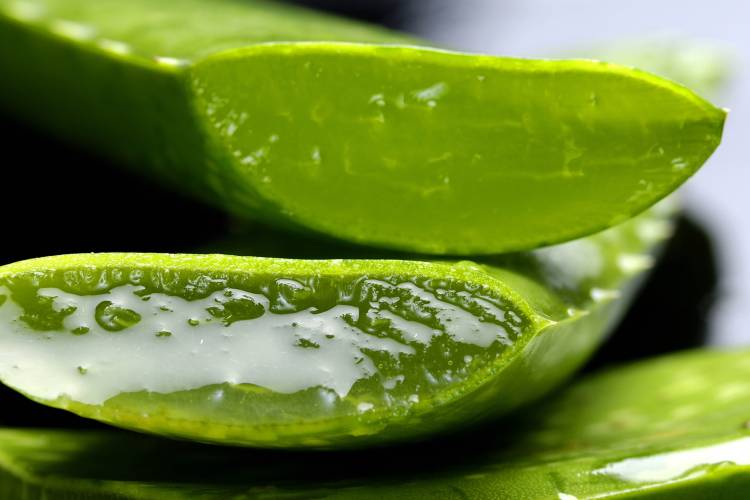
Cut Aloe leaf, Ingold Franziska, Pixabay
Fertilizing
When it comes to fertilizing Aloe, like with most houseplants, if you repot regularly, there is no need to fertilize. Fresh soil will provide additional nutrients.
Since Aloe Vera’s native environment is nutrient-poor soil, the plant barely needs any extra nutrition. In case you find it necessary, fertilize during the growing season and avoid all-purpose fertilizers. Instead, use those formulated for succulents.
Potting Soil
Being a succulent, standard tropical potting soil mixes are not the best choice for Aloes, as they retain a lot of moisture. Instead, aloe needs fast-draining and airy soil.
I make my own succulent mix of perlite, bark, and peat moss. You too can make your own – mix 2 parts peat moss-based potting mix with 1 part perlite and 1 part bark. Or to make it easier, you can use this ready-made Succulent & Cacti Mix.
Repotting
To repot your aloe, I suggest using a terracotta pot. Get the next pot size – if your current pot is 4” wide, go for a 6” pot. Fill about 1/3 of the new pot with soil. Now take your aloe plant out of its current pot and lightly loosen the rootball. Go ahead and place your plant in its new container, then add more soil to fill the remaining space. Press the soil firmly and make sure your aloe is potted at the same depth as before.
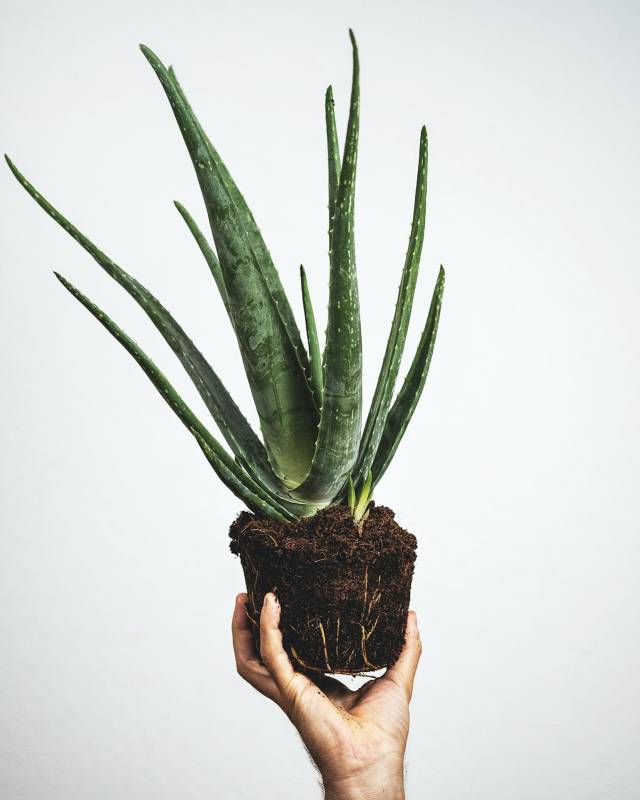
Aloe plant in soil growing some new pups, Severin Candrian, Unsplash
Temperature
Aloe prefers a warm climate: between 70°F and 85°F (21C and 30C). However, it will tolerate temperatures down to 50 degrees Fahrenheit. This succulent is intolerant to freezing temperatures and cold drafts. If exposed to extremely low temperatures for an extended period, your plant will struggle and it may not survive for too long.
Humidity
Aloe Vera plant will thrive in environments with low humidity: from 5% to 24%. Think of its African origins and you’ll understand why it doesn’t require much humidity. In case you live in a humid climate, don’t worry – you can still grow Aloe, it will adapt to high humidity without any problems.
Toxicity for Humans
The two primary components of Aloe’s leaf are used in health care products – clear gel and yellow latex. According to the Mayo Clinic, Aloe Vera gel is considered safe for topical use. It can be effective in treating different types of skin conditions. It helps treat burns, wounds, acne, psoriasis, and other skin conditions.
Toxicity For Pets
Using Aloe latex orally or giving it to your pet is not advised according to the Mayo Clinic. They state that oral use of Aloe latex or whole-leaf extract is likely unsafe. Oral use might even have the potential to cause cancer. To learn more about aloe topical and oral use, take a look at the Mayo Clinic’s article.
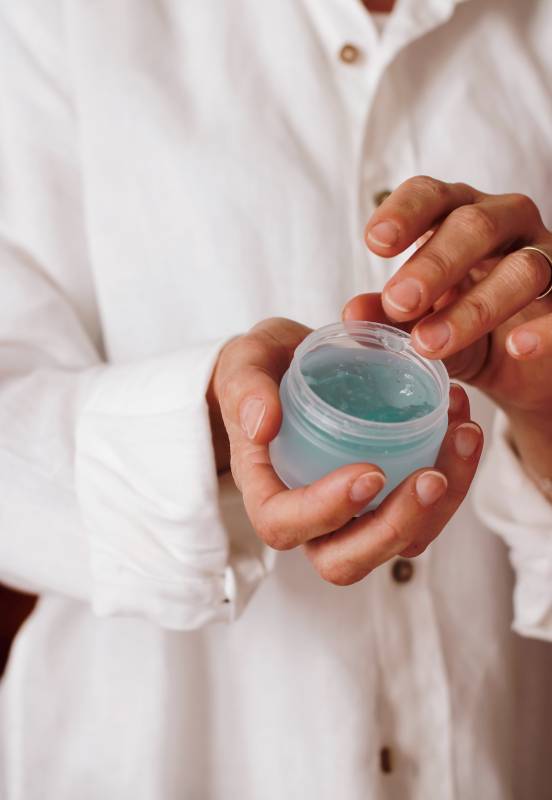
A person holding Aloe gel cosmetic product, Nati Melnychuk, Unsplash
Propagating Aloe Plants
Propagating Aloe Plants is super easy through a method called division. Just cut or break off one of the plants and pot it in the soil. Ideally, the rhizome that you are separating should already have some roots, but even if it doesn’t, it’s not that important, it will grow them.
You can see how I’m propagating Aloe in my video below.
Pests and Diseases
Pests
The most common pests affecting Aloe Vera (Aloe Barbadensis) are:
- Aloe vera aphids (Aloephagus myersi)
- Mealybugs
Aloe vera aphids are orange-brown or dull-green insects with oval bodies covered with fuzzy whitish wax. Both nymphs and adult insects feed on curled ends of damaged leaves or at the bases of the leaves. These insects produce honeydew which leads to sooty mold forming. In cases of severe infestation, the plant’s growth is stunted.
The best way to get rid of aphids is the application of insecticidal soap. This product will smother the insects. When applying insecticidal soap it’s important to carefully follow the instructions on the packaging, to avoid accidentally damaging your Aloe vera. You can also use a mixture of dish soap and water. Mix 2 teaspoons of liquid dish soap with one gallon of water. Spray the plant thoroughly and wipe it with a cloth to remove the insects, eggs, and honeydew.

Damage that caused aphids on Aloe Vera plant, Jeffrey W. Lotz Organization: Florida Department of Agriculture and Consumer Services
Mealybugs are small insects covered with cottony, white wax. They are usually found on leaf axils (where the leaf meets the stem), and they feed by sucking out sap with their thread-like mouthparts. If the mealybugs infestation becomes severe it will cause defoliation, yellowing of leaf tissue, stunted growth, and wilting.
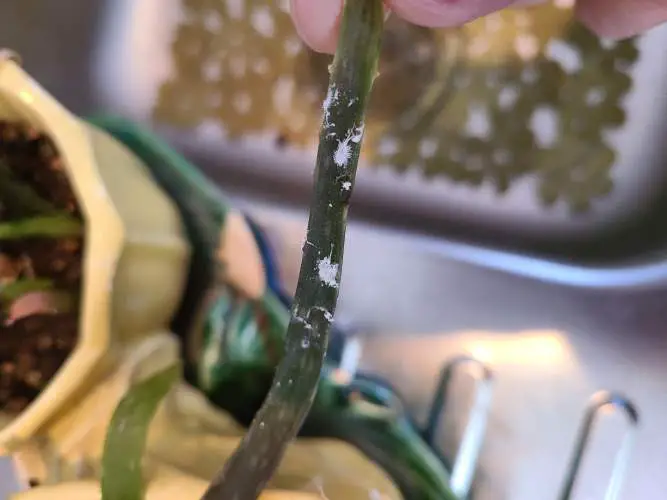
Mealybugs on Aloe Vera plant, University of Minnesota
Monitor your Aloe vera carefully, since catching the infestation in its early stages is crucial for saving the plant. You can treat minor mealybugs infestation with cotton swabs dipped in rubbing alcohol. Wipe down all the plant parts that are infested. You might have to repeat the process a couple of times. Another great method is spraying your Aloe vera with diluted dish soap and water.
Diseases
Fungal
The most common fungal disease affecting Aloe vera are:
- Aloe rust (Phakopsora pachyrhizi)
- Anthracnose disease (Colletotrichum gloeosporioides)
- Basal stem rot (Fusarium spp.)
Aloe rust is a fungal disease whose symptoms include small and pale yellow spots on foliage that enlarge and become brown. Sometimes you can also find orange spore masses on the underside of leaves, and the leaves might drop from the Aloe vera plant. The plant is more susceptible to aloe rust if it’s grown in cool temperatures and high humidity.
Once Aloe rust develops it can’t be treated. The best way to avoid this disease is to buy healthy plants. When buying Aloe vera, inspect the plant and choose a plant that’s sturdy and lush. Provide your plant with adequate light and avoid overwatering.
Anthracnose disease is another common fungal disease characterized by small round dark-green lesions which develop into circular spots with tan to light brown center. As these lesions mature, their centers become reddish brown or brown. Eventually, these lesions expand and join together, forming a big necrotic area. Favorable conditions for this disease are wet and warm weather.
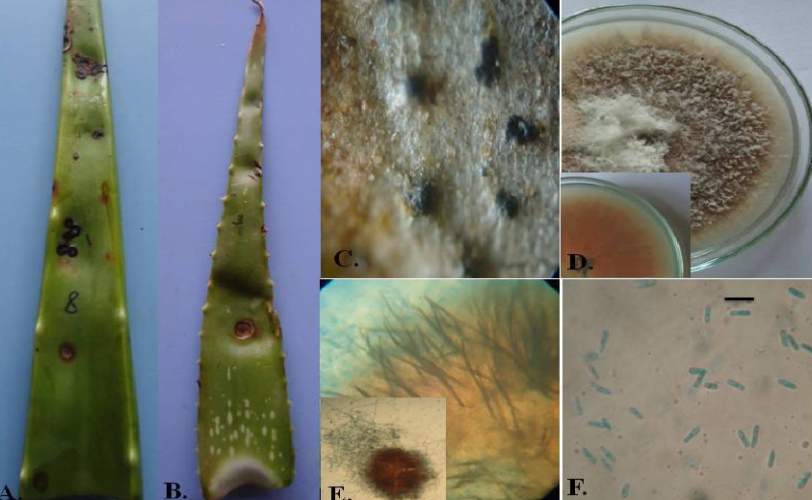
a) Anthracnose and coalesce symptom b) Anthracnose symptom c) Acervuli of Colletotrichum gloeosporioides d) Seven-day old Culture of Colletotrichum gloeosporioides e) Acervuli with dark brown setae f) Conidia of Colletotrichum gloeosporioides, ResearchGate
Once the symptoms develop, anthracnose cannot be cured. Prevention is the key when it comes to this disease. Buy healthy plants, space them far enough to maximize air circulation, implement good watering practices and provide sufficient light. Plants that get sufficient light are more resistant to pests and diseases.
Basal stem rot is caused by Fusarium fungi species. The main symptoms include the base of the Aloe vera plant becoming reddish brown to black and showing signs of rotting. Cold and damp conditions make the plant more prone to basal stem rot.
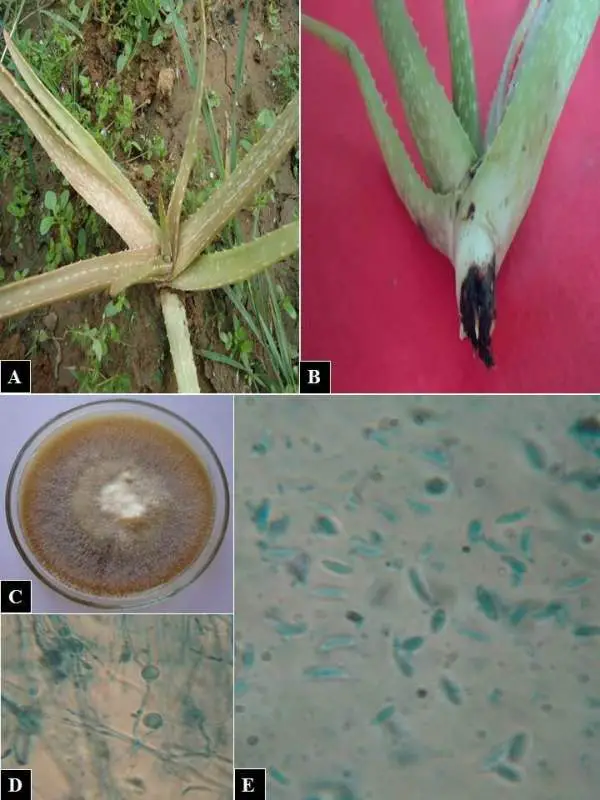
Fusarium solani causes disease symptoms:a & b) root rot, c) culture on PDA, d) Macroconida, e) chlamydospores, ResearchGate
Unfortunately, this disease is difficult to treat. You can try to save your Aloe vera by pruning the affected tissue and roots and repotting it. However, this does not always work if the disease has spread, and your best bet is to take a healthy cutting above the affected area and propagate the plant.
Bacterial
The most common bacterial disease found in Aloe vera is bacterial soft rot (known as Pectobacterium chrysanthemi).
The leaves of the affected Aloe Vera become darker in color and start to rot, whereas the young leaves start to wilt and collapse. Leaves might also start to bulge due to gas formation inside them. Bacterial soft rot is more common in hot and wet weather.
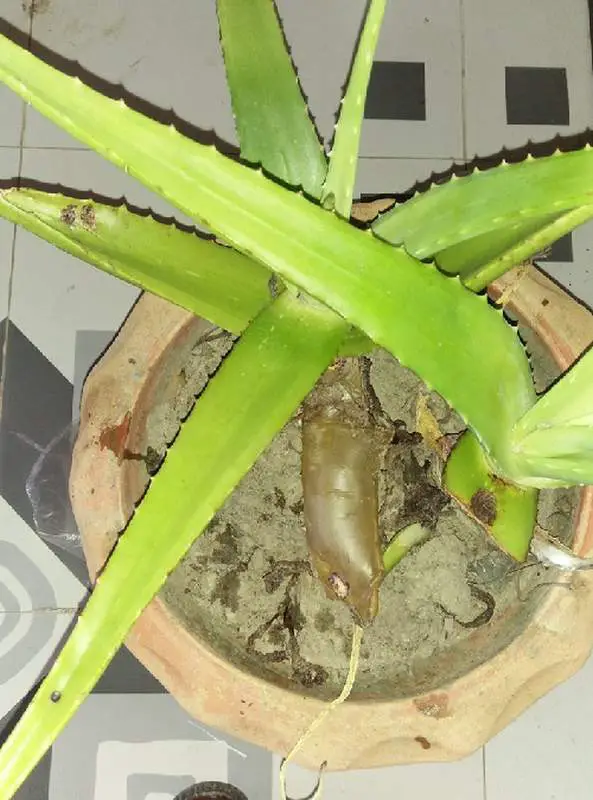
Pectobacterium chrysanthemi causes bacterial soft rot, Semantic Scholar
Once bacterial soft rot affects the plant, there is no treatment. You should immediately discard the plant to avoid contamination and the spread of the disease. You can prevent the disease by picking vigorous Aloe Vera plants and providing them with optimal care. Use a well-draining potting mix (for succulents and cacti) and establish an adequate watering schedule, to avoid overwatering.
Common Problems
Although Aloe Vera is known as a sturdy and low-maintenance plant, sometimes plant owners can be faced with certain challenges and problems, which can be resolved in most cases. These are the most common problems with Aloe vera plants:
Yellow Leaves
The leaves of Aloe vera can become yellow due to many different reasons. One of the most common reasons is overwatering. Aloe vera is not a thirsty plant, and it doesn’t need to be watered frequently. The watering frequency will depend on many environmental factors. The rule of thumb is to water your Aloe vera when the soil dries out completely, all the way to the bottom of the pot. Ensure that you’re using a porous and well-draining potting mix and that the pot has drainage holes.
Aloe vera leaves can also turn yellow if they’re suffering from severe mealybugs infestation. It’s vital to inspect your plant regularly and act quickly to prevent severe damage or plant death.
Brown Leaf Tips
Aloe vera leaf tips can become brown due to underwatering. If you notice that the tips of the leaves are turning brown, you should check the soil and see if it’s completely dried out. If the plant hasn’t been watered adequately, you should hydrate your plant thoroughly, and it will spring back.
If other parts of leaves or plants are turning brown, you’re most likely dealing with a fungal or bacterial disease. Keep in mind that the leaf tips won’t recover, so if you find them aesthetically unappealing, you can prune them.
Limp and Pale Leaves
Aloe vera leaves will become pale and weak if the plant doesn’t get sufficient light. When Aloe vera doesn’t get enough light, it can’t produce chlorophyll, which is necessary for photosynthesis. To prevent this, give your plant enough light. The more light you can provide, the better.
However, you must do this gradually to avoid sunburns on the leaves. Move the pot to an area with direct sunlight and start exposing the plant to direct sunlight for one hour a day. Continue for one week. Then, on the second week increase the exposure for one hour, for a total of two hours. Continue increasing the exposure until your plant gets used to direct sunlight. Slow and steady is the key, to avoiding stressing the plant.
Aloe Vera Pruning
In general, there is no need to prune an aloe plant if all the leaves are green and healthy. As the plant matures, older leaves will dry out and die and you can prune them.
Use sharp and disinfected pruning tools to prune your Aloe. You can use hydrogen peroxide product to disinfect the tools. A pair of scissors, a knife, or gardener’s shears will do the job – just make sure they’re sharp enough. Identify dead or shriveled aloe leaves and remove them.
Care Tips
If you want to grow a healthy and lush Aloe Vera plant, follow these care tips:
- Aloe Vera thrives in direct sunlight. Place your plant in front of a window that gets the most sunlight. For people living in the northern hemisphere, this would be a south-facing window. If you can’t give your plant enough natural light, consider purchasing a grow light.
- Provide your plant with enough water. Aloe Vera plants are drought-tolerant, and it’s important not to overwater them, or else they will become more susceptible to pests and diseases. Water the plant only when the soil is fully dried out to the bottom of the pot.
- Well-draining soil is a must when it comes to Aloe vera plant care. To achieve optimal soil drainage, you can amend a store-bought potting mix with 30-50% of perlite, vermiculite, bark, or some other amendment. Use pots with drainage holes, or if they don’t have them, add them yourself (drill the holes).
Aloe Vera plants are a great choice for beginners since they’re easy to care for. With just a little bit of care, they will thrive and embellish your indoor garden.
FAQ on Aloe Vera
Is Aloe Vera an Indoor or Outdoor Plant?
The Aloe Vera plant can be grown both indoors and outdoors. Naturally, all plants are outdoor plants but that doesn’t mean they can’t thrive in our homes. Indoor gardening makes it easier to control the environment and create perfect conditions for plants. On the other hand, growing Aloe Vera outdoors had its own advantages too – there is so much more light than indoors which makes it really hard to overwater a plant. Once you learn how to care for an Aloe Vera, you’ll have a healthy plant whether it’s in your home or garden year-round.
How to Grow Aloe Vera Outdoors
To grow Aloe Vera outdoors, start by finding a spot in your garden that gets partial sun and has well-draining soil. Aloes love full sun, but you need to acclimate them gradually to it, otherwise they might get sunburned.
Once you’ve found the perfect spot with partial sun, place the pot in that spot for a week or two. Each week keep increasing exposure to direct sun, until the plant is fully acclimated to direct sun.
At that point you can either leave the plant in its pot or pot it directly into the garden. Dig a hole that’s twice the size of the Aloe Vera’s root ball and mix in some compost. Gently place the plant in the hole and backfill it with soil. Water the Aloe Vera deeply and regularly for the first few weeks until it’s established. After that, you can water it less frequently.
With the plant being outside your home you don’t need to worry about overwatering as much as indoors, as the plant is getting much more light and is also exposed to wind, which is drying out the soil, so it’s very difficult to overwater an aloe outdoors.
Why Is My Aloe Turning Red?
Aloe plants can vary in color, but they are typically green. However, some aloe plants will turn red, especially when they are exposed to direct sunlight. But don’t worry, there is nothing wrong with your plant.
The red color is due to anthocyanins, which are pigment molecules that absorb light. Anthocyanins are found in many plants, and they can range in color from red to purple. When an aloe plant turns red, it is usually a sign that the plant is stressed. This can happen if the plant is not getting enough water or if it is exposed to a lot of direct sunlight.
Do Aloe Plants Need Direct Sunlight?
Aloe Vera is best grown in direct sunlight. However, it will tolerate low light too. The difference is that leaves will change shape and lose spikes if grown in low-light conditions. And if you like that look, that’s just fine. But, when they get enough direct sun, their leaves become firmer, develop small “spikes”, for the lack of a better word, and often change color. They start growing in a different way, and to me personally, they look much more aesthetically pleasing.
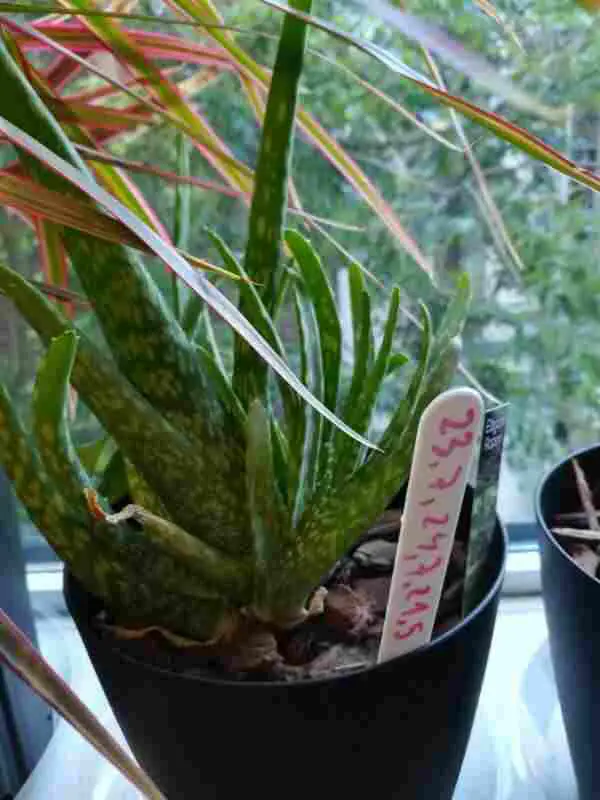
Aloe Vera in my office. Notice the leaves are relatively firm and have started developing tiny spikes
What Does an Overwatered Aloe Plant Look Like?
An overwatered aloe plant can be recognized by its leaves. The leaves will be soft and mushy, yellow, brown, or black and wilted. The leaves may also fall off easily.
How to Get Your Aloe Vera to Flower
It is not difficult to get your aloe Vera plant to flower, but it does require a little bit of care and attention. Here are the steps you need to take to ensure your plant blooms:
- Aloe Vera plants need a lot of sunlight in order to bloom, so make sure it is placed in a sunny spot. If you live in an area with long winters and short summers, you may need to supplement your plant with artificial lighting.
- The soil your plant is growing in also needs to be well-drained. Aloe Vera plants are susceptible to root rot, so it is important to make sure the soil is not too wet.
- Once your plant is about two years old, you can start to fertilize it with a high-phosphorus fertilizer. This product will encourage the formation of flowers.
- Aloe Vera plants typically bloom in the late summer or early fall.
With a little bit of care and attention, you can easily get your Aloe Vera plant to flower. Just make sure it has enough sunlight and well-drained soil.
How to Protect Aloe Vera Plant in Winter
There are a few things you can do to protect your aloe vera plant from the cold weather in winter. First, if you keep the plant in the outdoor garden, you can move it indoors for the winter and place it in a bright spot that gets plenty of direct sunlight. Second, you can water it less often, as the plant will need less water in the cooler months than in summer. This will reduce the chances of root rot. Third, if you are leaving the plant outside your home during winter, you can apply a layer of mulch around the base of the plant to help insulate the roots from the cold. By following these simple tips, you can help your aloe vera plant survive the winter months.
How to Know Is My Aloe Vera Plant Healthy?
If you want to know if your Aloe Vera plant is healthy, there are a few things you can look for. First, check the leaves for any brown spots or yellowing. If the leaves are green and healthy-looking, that’s a good sign. Another good sign is if the plant is producing new leaves. Finally, check the root system to make sure it is white and healthy. If the plant is missing any of these signs, it might be unhealthy.
What Are the Best Aloe Vera Growing Tips?
- Aloe Vera plants prefer a location with direct sun. If you live in an area with limited sunlight, you can place your plant in front of a south-facing window.
- If you don’t have a lot of light, and your plant’s leaves are limpy, get a grow light.
- These plants are drought-tolerant, so you don’t need to water them too frequently. Wait for the soil to fully dry out to the bottom of the pot before watering. This can take one or several weeks, depending on your environment.
- Aloe Vera plants need well-draining soil. Amend your potting mix with 30-50% perlite, bark or another amendment. If your pot doesn’t have a drainage hole, be sure to add one. Even though it’s possible to grow aloe vera in pots without a drainage hole, a hole makes it easier, especially for beginners.
With just a little bit of care, your Aloe Vera plant will thrive and provide you with plenty of benefits.
Yours Truly,

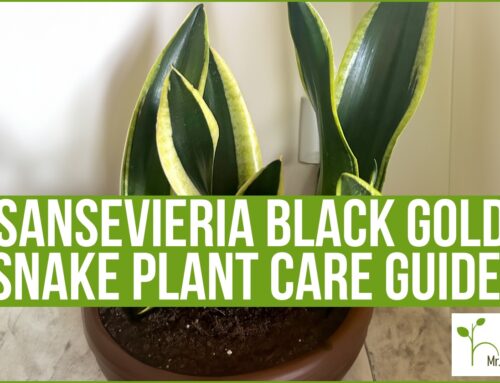

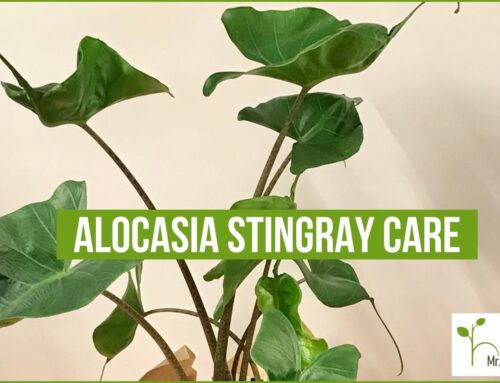


Best advice / most helpful I’ve ever read many thanks
Thank you! I’m glad it was helpful :)
I have a bottle of chlorophyll for human consumption. It has a mint flavor. Can I use this to feed my aloe plants
Hi Dawn, I wouldn’t recommend using the bottle of chlorophyll to feed plants. Plants synthesize chlorophyll, if you provide them with sufficient light, there is no need to provide it. I am also unsure if they can actually get chlorophyll in the way you would like to provide it.
Plants need micro nutrients and macro nutrients for proper growth. An excellent fertilizer is this one: https://www.mrhouseplant.com/recommends/fertilizer/
Great tips for keeping your aloe vera plant healthy and thriving – I’ll definitely be using these!
Thanks Tina!